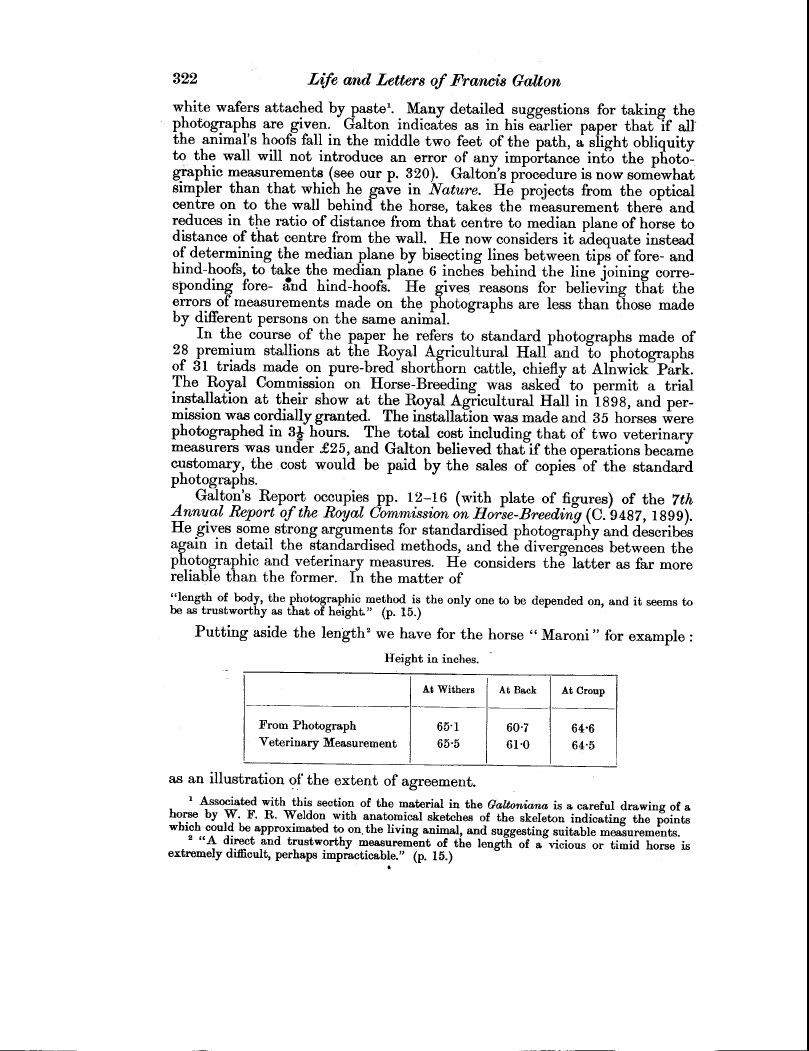322 Life and Letters of Francis Galton
white wafers attached by pastel. Many detailed suggestions for taking the photographs are given. Galton indicates as in his earlier paper that if allthe animal's hoofs fall in the middle two feet of the path, a slight obliquity to the wall will not introduce an error of any importance into the photographic measurements (see our p. 320). Galton's procedure is now somewhat simpler than that which he gave in Nature. He projects from the optical centre on to the wall behind the horse, takes the measurement there and reduces in the ratio of distance from that centre to median plane of horse to distance of that centre from the wall. He now considers it adequate instead of determining the median plane by bisecting lines between tips of fore- and hind-hoofs, to take the median plane 6 inches behind the line joining corresponding fore- and hind-hoofs. He gives reasons for believing that the errors of measurements made on the photographs are less than those made by different persons on the same animal.
In the course of the paper he refers to standard photographs made of 28 premium stallions at the Royal Agricultural Hall and to photographs of 31 triads made on pure-bred shorthorn cattle, chiefly at Alnwick Park. The Royal Commission on Horse-Breeding was asked to permit a trial installation at their show at the Royal Agricultural Hall in 1898, and permission was cordially granted. The installation was made and 35 horses were photographed in 31 hours. The total cost including that of two veterinary measurers was under £25, and Galton believed that if the operations became customary, the cost would be paid by the sales of copies of the standard photographs.
Galton's Report occupies pp. 12-16 (with plate of figures) of the 7th Annual Report of the Royal Commission on Horse-Breeding (C. 9487, 1899). He gives some strong arguments for standardised photography and describes again in detail the standardised methods, and the divergences between the photographic and veterinary measures. He considers the latter as far more reliable than the former. In the matter of
"length of body, the photographic method is the only one to be depended on, and it seems to be as trustworthy as that of height." (p. 15.)
Putting aside the length2 we have for the horse " Maroni " for example
Height in inches.
| |
At Withers |
At Back |
At Croup |
|
From Photograph |
65.1 |
60.7 |
64.6 |
|
Veterinary Measurement |
65.5 |
61.0 |
64.5 |
as an illustration of the extent of agreement.
I Associated with this section of the material in the Galtoniana is a careful drawing of a horse by W. F. R. Weldon with anatomical sketches of the skeleton indicating the points which could be approximated to on, the living animal, and suggesting suitable measurements.
2 "A direct and trustworthy measurement of the length of a vicious or timid horse is extremely difficult, perhaps impracticable." (p. 15.)

